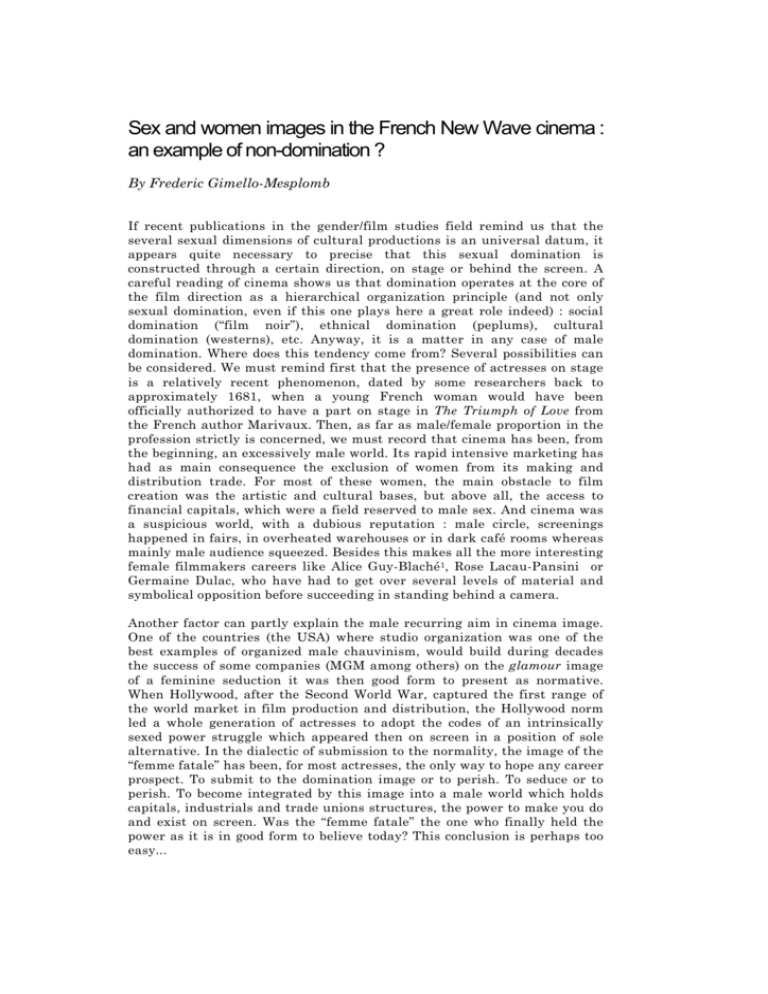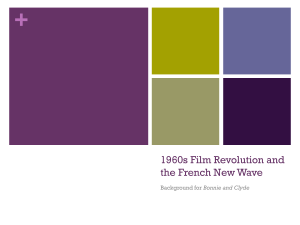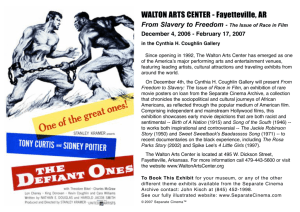
Sex and women images in the French New Wave cinema :
an example of non-domination ?
By Frederic Gimello-Mesplomb
If recent publications in the gender/film studies field remind us that the
several sexual dimensions of cultural productions is an universal datum, it
appears quite necessary to precise that this sexual domination is
constructed through a certain direction, on stage or behind the screen. A
careful reading of cinema shows us that domination operates at the core of
the film direction as a hierarchical organization principle (and not only
sexual domination, even if this one plays here a great role indeed) : social
domination (“film noir”), ethnical domination (peplums), cultural
domination (westerns), etc. Anyway, it is a matter in any case of male
domination. Where does this tendency come from? Several possibilities can
be considered. We must remind first that the presence of actresses on stage
is a relatively recent phenomenon, dated by some researchers back to
approximately 1681, when a young French woman would have been
officially authorized to have a part on stage in The Triumph of Love from
the French author Marivaux. Then, as far as male/female proportion in the
profession strictly is concerned, we must record that cinema has been, from
the beginning, an excessively male world. Its rapid intensive marketing has
had as main consequence the exclusion of women from its making and
distribution trade. For most of these women, the main obstacle to film
creation was the artistic and cultural bases, but above all, the access to
financial capitals, which were a field reserved to male sex. And cinema was
a suspicious world, with a dubious reputation : male circle, screenings
happened in fairs, in overheated warehouses or in dark café rooms whereas
mainly male audience squeezed. Besides this makes all the more interesting
female filmmakers careers like Alice Guy-Blaché1, Rose Lacau-Pansini or
Germaine Dulac, who have had to get over several levels of material and
symbolical opposition before succeeding in standing behind a camera.
Another factor can partly explain the male recurring aim in cinema image.
One of the countries (the USA) where studio organization was one of the
best examples of organized male chauvinism, would build during decades
the success of some companies (MGM among others) on the glamour image
of a feminine seduction it was then good form to present as normative.
When Hollywood, after the Second World War, captured the first range of
the world market in film production and distribution, the Hollywood norm
led a whole generation of actresses to adopt the codes of an intrinsically
sexed power struggle which appeared then on screen in a position of sole
alternative. In the dialectic of submission to the normality, the image of the
“femme fatale” has been, for most actresses, the only way to hope any career
prospect. To submit to the domination image or to perish. To seduce or to
perish. To become integrated by this image into a male world which holds
capitals, industrials and trade unions structures, the power to make you do
and exist on screen. Was the “femme fatale” the one who finally held the
power as it is in good form to believe today? This conclusion is perhaps too
easy...
Women images in French cinema during the 50’s (cinema of Quality).
The French cinema Quality, during the 50’s, has built its doxa on very
simple tools: polished screenplays, authors with wide technique experience,
but above all, a “starification” policy modeled on American cinema from
which French trade unions wanted yet (already) to protect themselves.
Anyway, as far as sex relationship image is concerned, in the Victorine
Studios (in Nice) the same myths as in Hollywood were produced. Without
the magic... On screen, Danielle Darrieux, Edwidge Feuillière or Martine
Carol (brought to fame in 1951 thanks to Caroline Chérie from Richard
Pottier) have never been famous but in roles tailor-made by authors more
preoccupied to preserve morality than to give to women a position from
which they actually could have thrown male actors into a weak position.
The French specialist Jacques Siclier noticed in 1961: “this continuous
beeding overstatement concerning great stars engaged because they had
audience high favor has increased the misunderstanding which has always
existed. A film built with Fernandel, Pierre Fresnay, Jean Gabin, Gérard
Philippe, Edwidge Feuillière, Michelle Morgan, Martine Carol, Danielle
Darrieux, Françoise Arnoul or Brigitte Bardot had no aim but to highlight,
in roles defined by their physique or moral personality, precise actors or
actresses who were then endowed with a diegetic personality. We arrive so to
films which are all quite similar, in which actors come to play the role they
are asked to. This performer specialization distorts partly audience tastes.
The audience who doesn’t “recognize” Martine Carol in Lola Montes (Max
Ophuls, 1955), nor Françoise Arnoul in Sait-on jamais (No sun in Venice,
Roger Vadim, 1957) fires then commercial failures which wouldn’t have been
if many years of Quality tradition hadn’t fixed invariable norms”.
So, from Le Salaire de la Peur (Wages of Fear, Clouzot, 1953) to Des gens
sans importance (Verneuil, 1955), Françoise Arnoul would go on acting an
enticing and servile waitress, as well as Dany Carrel would act a fragile and
shy ingenue from La cage aux souris (Jean Gourget, 1953) to La Môme
Pigalle (Alfred Rode, 1955), including Ce corps tant désiré (Luis Saslawski,
1959). So, according to the French researcher in film history Catherine
Gaston-Mathé, “This cinema tries to seduce hypothetical average spectator,
limiting considerably the freedom of expression and leading to conservatism.
Leading to decrease potential conflicts, it creates and conforts social and
political conformism. Casting out what may divide, it neglects controversial
subjects and produces an altered portrait of realities.” 2
Male domination will find so in French Quality cinema some kind of a
confort and a legitimacy settled at the very core if the scenarios. The
flaunting on screen of tantalizing starlets didn’t change anything at the
base; for the best, it created an obvious down-toning of any subversive idea.
So, a whole piece of the hexagonal production will develop parallel to (and to
some extent against) the sexual image of Quality cinema, by exploiting the
symbol of urban prostitution and the woman alienation to vice rather than
to urge to work. French filmmakers such as Maurice Cloche (Bal de Nuit,
1959), André Berthomieu (Pigalle-Saint Germain des Près, 1950), Léoni de
Moguy (Le long des trottoirs, 1956 and Piège à filles, 1957), Ralph Habib
(Les compagnes de la nuit, 1953), Michel Boisdron (Cette sacrée gamine,
1956), Roger Richebé (La fille Elisa, 1956), Denis de la Patellière (Le salaire
du Péché, 1956) or the Bordeaux citizen Emile Couzinet (Quai des illusions,
1956) will use women image by producing a lot of reactionary and squalid
melodramas in which feminine seduction was shown as the inescapable
anteroom to street-walking. As he analyzed in 1996 the 50’s cinema
thematic, the French researcher in film Noël Burch (University of Lille) and
Canadian researcher Genevieve Sellier had been surprised by the number of
films which, without directly dealing with prostitution, could as well be
thematically linked with this last category: “We have listed at least 25% of
films setting out misogynous figures, with different variants. These are films
directing “malefic sluts” who cause besides consciously or unconsciously
misfortune of men, or films in which woman are always punished by death
most of the time for having tried to build their life in an autonomous way”.3
In this manner, the scandal surrounding Les Amants (The Lovers), a French
movie from Louis Malle (1958), would have mainly come from the fact that,
at the epilogue of the film, the woman stayed alive and unpunished. From
this dominant ideology of French cinema of the 50’s, women image stands
out as directed with a rare manicheism : innocent virgin or prostitute.
New Wave films and family relationship. For, be it theorist Andre Bazin
in his article “La carolinisation de la France” (Esprit review n° 22, 1954, in
reply to the movie Caroline Chérie from Christian-Jaque), François Truffaut
in his famous lampoon “Une certaine tendance du cinéma français” (“A
certain trend of French Cinema”, Cahiers du Cinéma n° 31) or Jacques
Doniol-Valcroze in his article “Déshabillage d’une petite bourgeoisie
sentimentale” (idem), the hostility of the “authors policy” as far as Quality
cinema will emerge first about this question of the “starification” and about
roles assigned to women in French cinema. This is a drift which “young
Turks” will carefully avoid when standing behind a camera, by establishing
their own feminine figures: Emanuelle Riva, Bernadette Lafont, Jean
Seberg, Delphine Seyrig, Anna Karina, Jeanne Moreau and Brigitte Bardot.
Just like the title of the Godard’s film Masculin/Féminin (MasculineFeminine, 1966), most French New Wave films show us that one of the
original aspects of the movement is first and foremost a new image of sex
relationship whereas most films from 30’s to 50’s had given the image of
patriarchal and bourgeois families in which marriage legalized insertion of
women into society rather than it officialized a real or alleged love
situation. 4 Films in which Jean Gabin is directed show very clearly this
tendency to praise a domineering by a patriarch with a liberal profession
(property owner, attorney, lawyer, gang leader...) and to legitimate the
ambiguous repulsion/attraction relationship he has with an (always) young
wife, relationship which can in certain films, be shown as being both
conjugal or incestuous. On that last subject, we can but notice that the New
Wave avoids to reproduce the dominant myths: patriarchs and eternal
feminine. Bardot’s image (even if it has been used by the Qua
lity
filmmakers in a way quite similar during almost 17 films) grows away from
that with Roger Vadim in 1958. In part only, but, for the filmmaker : “The
scene in “Et Dieu créa la femme” which has much shocked is not on where
Bardot is seen nude; it’s the scene where, during the Sunday meal, Bardot
insolently comes down into the dinning room to take, in front of her mentor,
some drumsticks to feed her lover. In fact, this very sequence, which gave a
bad image of the traditional family, caused most of the hostile reactions”. 5
From that point of view, the revolution embodied by Bardot seems to be
rather a (r)evolution of social and familial values than a real renewal of
women purely sexual image.
Nudity on the screen, be it of an erotic essence or not, is actually a point of
reference to rate the society evolution and its permissiveness progress. 6
However, a careful reading of French New Wave films shows us rapidly that
the development of women nudity on screen doesn’t seem to be due rather to
the New Wave filmmakers than to the ones who preceded or followed them.
It is yet one of the common confusions concerning the French New Wave,
whose contribution has been willingly reduced to a clean eroticism and a
Parisian licentiousness in intellectual circles, that is to say to the average
components of the contemporary French cinema... This reduction is a
mistake. It is too a wrong reading. It would mean to forget that French
Censorship Committee still imposes in 1964 to Jean-Luc Godard to cut a
harmless shot showing panties falling along Macha Méril’s legs in “Une
femme mariée” (A married woman). The CNC (Center of Cinema, Ministry of
Culture) committee asks, in its 12.5.62 meeting, for “cuttings” in the
dialogue of Les Vierges (The virgins, Jean-Pierre Mocky, a film whose export
will finally be forbidden) and the same committee demands, on the 03.27.63,
a pre-censorship notice (“because of the subjects they deal with”...) for JeanLuc Godard’s movie Le Mépris (Contempt) and Roger Vadim’s movie
Châteaux en Suède (Nutty, Naughty Château, 1963). Idem for Les Cousins
(Chabrol, 1958), Jules & Jim (Truffaut, 1961) and Vivre sa Vie (My life to
live, Godard, 1962), films forbidden to less than 18 years. 7 We must
remember the scandalized headlines which came out in press on the day
following the sound slap inflicted by the French filmmaker Henri-Georges
Clouzot to Bardot on the shooting of La Vérité (The Truth, 1960), after that
the girl called him, in reply to the filmmaker’s somewhat smutty behavior,
“an old sadist”. Curiously, it is actually the whole French society which has
been scandalized by Brigitte Bardot gesture. This society was all the more
rural and it got with difficulty from a period to another...
We must at least remind too that contraception modes were completely
forbidden, as well as films, magazines, broadcastings reflecting, at any rate,
a sexual nature, whereas governors at that period kept on hounding,
throughout the country, films and written works which could have,
implicitly or not “incited to debauchery”. No allusion neither to women
sexuality in official media, radio and television.
Women new image. The other big novelty of the French New Wave
cinema as far as domination relationship is concerned, up to then largely
favorable to male desire image, will be to give up the traditional “setting” of
actresses as phantasmagorical object to make now live on screen women
characters assuming their sexuality much more freely. The French actress
Jeanne Moreau noticed in 1965 about the 50’s cinema : “You know that
beauty examples were then very strict. An actress had to be of a certain type
and not of an other. It was the period of fair-haired women. Martine Carol’s
great time. Yet, something has changed: actresses are not talked about as
they were. I was just now talking about past actresses: I think they were most
of time created by misogynists. Today, I think that filmmakers love women
more than then”.8 Marcel Hanoun, a filmmaker associated to the New Wave
early stages, relates so in Le Huitième Jour (1959) the life of a lonely and
inhibited woman (Emmanuelle Riva) trying to overcome her difficulties in
communicating with men. Timidity is too directed by François Truffaut in
Tirez sur le pianiste (Shoot the piano player) (1961): the scene of the troll
between Aznavour and Marie Dubois clearly shows the admission of
helplessness of the male hero, which could not have been imagined some
years before, at Gabin’s blessed time, Marais’s or Gérard Philippe ‘s. In
1958, the Catholic Church Film Committee asks for boycotting Louis Malle’s
movie Les Amants (The Lovers, 1958) for “inciting to debauchery” : we could
here see Jeanne Moreau showing real signs of pleasure during the love
scene with Jean-Marc Bory. Next year, voices raise against “eroticism” in
Hiroshima mon Amour (Alain Resnais, 1959) but here, once more, it is less
against the couple’s close-ups, elliptical and made highly aesthetic, than
because of the way Emmanuelle Riva shot her film in Japan (using a
passing lover...). Le Mépris (Contempt) from Godard is to be situated too on
the opposite side from women dominant image in cinema: Bardot known as
a popular star handed over in this film to Bardot/Camille as an actress,
asexual subject or rather de-sexued subject, subject voluntarily made non
desiring. The famous sequences (imposed by the American production) of
Bardot nude (among them, the notorious opening scene) will be directed by
Godard infringing here throughout cinematograph sexual and social codes:
he brought Bardot’s body to an iconic –almost plastic- dimension. At last, if
Jacques Rivette, an other New Wave filmmaker, endures in 1966 wrath
from both governmental and ecclesiastical censorship, it rather comes from
the story of the difficulty with which the nun Simone Simonin assumes her
sexual ascetism than from the real plastic quality of a film situated far from
an anticlerical lampoon, nor, to use Gérard Lenne’s expression, from “a
pornographic variation about convents’ scandal”. 9 In a word, French New
Wave cinema often thwarts a kind of neo-moralism by placing women in a
strong position, for the expression on screen of their feelings is
paradoxically as well sought after and feared by male power. In that way,
the other big egeria of that period, Michelle Mercier, who rose to fame in the
years after New Wave with the series of Angelique, embodies a clear retreat,
and this in spite of the soft eroticism which the series filmmakers want to
use, as well as the willingly provocative image of “a determined woman
seeking her destiny” (sic).
Questioned to know whether he had favored in his films women
image, Truffaut had argued : “as a character, yes, because I’ve often been
taxed to show weak men and women who decided, women who directed
events, but I think that life is so, it is anyway like that in my films. I’ve often
been blamed, that is to say that men are often angry with my films...”10 And,
concerning the main character in Jules & Jim (1962), a woman the
narrative sphere of activity is built upon : “Yes [it pleased the feminine
audience] because she was a woman in advance on her time...” 11
Yet, save Rohmer and Truffaut, it may be upon the love relationship
subject that the French New Wave cinema best managed to find the right
tone. After their first feats, Malle and Vadim will come back to films more
classical on formal level and clearly more conventional as far as the image
of women in their love relationship is concerned; this will tend to gradually
isolate them. Les Mauvaises Rencontres (1955) from Alexandre Astruc, a
filmmaker regarded as one of the New Wave “spiritual fathers”, already
linked women image with a clearly avowed male domination: Catherine
(Anouk Aimée) has a successful professional life in Paris (as a fashion
columnist) only after an affair with Blaise Walter (Jean-Claude Pascal), the
manager of an important Parisian daily newspaper, who will become her
mentor. Same mythology in Vie Privée (A Very Private Affair, 1961, a French
film entirely financed by MGM) from Louis Malle in which Brigitte Bardot
(a ballet dancer) is instrumentalized in male people hands, who hold
capitals and make from start to finish a celebrity which slips from a
supposed talent (which the film, of course, carefully omits). The films from
Jacques Doniol-Valcroze suffer too when out of familiar sceneries. l’Eau à
la Bouche (1959) which is surely one of the best examples : young people
and delicate debauchery in provincial upper-class circle. At last, in 1961,
Claude Chabrol suffers his first failure with Les Bonnes Femmes (The good
girls), hardly managing to find the right tone in that he wanted to be an
“filmed behavior analysis” about women. From that point of view Malle,
Vadim, Rohmer, Doniol-Valcroze and Chabrol can be regrouped together
apart from the New Wave, they distinguish from other filmmakers because
of their far more conventional influence concerning sex relationship, whose
origin can be found in Sade or in Choderlos de Laclos, that is to say in a
literary and intellectual trend which was underground in the XIXth century
and that surrealism would have restored in cinema just after the second
world war.
Moreover, the trend of non-male domination in the New Wave films
barely disguises a certain instrumentalization of woman image. The
tendency to try to market as such the “sexual revolution” image embodied
by Bardot paradoxically took the actress back to a far more “male
chauvinist” obedience cinema, characterized, at the beginning of the 70’s, by
a certain number of films which wanted to caricature sex struggle (Les
pétroleuses from Guy Casaril, 1971; Don Juan 73 from Vadim and Sex Shop
from Berri, 1972; Calmos, from Blier, 1973, etc.), but which seldom avoided
gratuitous moralism, even some populism.
This leads us to wonder whether sexual domination in cinema is not
indifferently lived through by both sexes, filmmakers as well as actresses,
the ones directing it in the name of market logic, the others submitting for
professional success. “Man behind camera, women on screen”, as Guy
Chapouillié said about Vertov’s film The Man with a Movie Camera (who
opened so onto a new field for women image). 12 In this hypothesis, isn’t
finally sexual domination in cinema unanimous submission to a sexed
cultural norm, the one conveyed by ordinary consumption commercial
cinema which reflects and bends society expectation and myths? This is
what the sociologist Pierre Bourdieu inferred in La domination Masculine
(The male domination, 1998), linked cinema and TV business to a
“conservative representation of sex relationship, which condenses the eternal
feminine myth”. 13 A conclusion on which the French criticism reviews
Cinéthique and Les Cahiers du Cinéma already lined up in the 70’s,
noticing that if social & sexual ideology is always considered as an
historically specific product, cinema cannot objectively escape from that :
“So, cinema is obliterated, from the first inch of showed-up film on, by this
inevitability of reproduction, not of things in their concrete reality, but as
through ideology”. 14
Far from being a fantasy of a supposed collective unconscious
(supposed, for popular imagination never works but on already provided
patterns), this eternal feminine image that cinema reproduces from its
origin seems inexorably linked with the medium. The French New Wave
sexual (r)evolutions would so have been perhaps, at a key-moment of
cinema history, to try to break free from it, and certainly in any way to
break free from this intrinsically male direction of relation to image, in the
sense the writer François Mauriac used it : “I am a voyeur, but I will never
see anything else as entirely , as intensely, as directly as in cinema : a whole
world to reach, some people say, a lost world to be found again, others say; in
any case a world which is not and which I can make mine...”
Frederic Gimello-Mesplomb *
* Graduated from University of California, Berkeley, and Ph.D in
film studies, Frederic Gimello-Mesplomb is actually a researcher at the
Audiovisual Research Laboratory (ESAV, Université Toulouse le Mirail,
France). He has, among other works, published for Soundtrack and Positif
many articles about the relationship between film & music, as well as texts
about the political and economical aspects of the French New Wave cinema.
He wrote a book dedicated to François Truffaut’s collaborator Georges
Delerue (Georges Delerue, Une Vie, Hélette : Jean Curutchet Press, 1998).
Work soon to come: Stakes and strategies within the policy of support for the
French cinema : from the New Wave to the new culture.
Notes
1. We owe her a recent rediscovery of the work : production in 1995 of the Canadian film
from Marquise Lepage “The forgotten garden: The life and work of Alice Guy-Blaché”,
publication in 1996 of “The Memoirs of Alice Guy-Blaché” by Anthony Slide (Scarecrow
Press, New York), and special issue of The Archives of the Cinema Library (Archives de
la Cinémathèque, Institut Jean Vigo, Perpignan, France, October 1996) dedicated to
Alice Guy-Blaché and coordinated by Alison MacMahan from the Women Film Pioneers
Project committee.
2. Catherine Gaston-Mathé, La société française au regard de son cinéma (French society
through its cinema) (Caen: Corlet, 1996) : 65.
3. Noël Burch & Geneviève Sellier “Règlements de comptes”, in Le cinéma français de la
Quatrième République (Paris: ed. Cinémathèque Française/Musée du Cinéma, 1993), 23.
4. Cf Ginette Vincendeau “Jean Gabin: anatomie d’un mythe” (Jean Gabin: anatomy of a
myth) (Paris: Nathan, 1994).
5. Interview with Roger Vadim. Author’s privates archives.
6. The works published at the Film dept. of the University of Bordeaux III by Martine
Boyer and Francis Hippolyte on this field are notable.
7. Commission in charge of the authorizations of shootings, councils of 5.12.62 and
27.03.63 (president Roger Salard, vice-president Raoul Ploquin), Kamenka inventory,
BIFI archives, Paris, 100 faubourg Saint Honnoré.
8. Cahiers du Cinéma 161-162 (January 1965) : 80.
9. Gérad Lenne “L’Erotisme au cinéma” (Erotism in cinema) (Paris: La Musardine, 1999).
10. “Truffaut Interviewed by Aline Desjardins” (Paris: Ramsay, 1987) : 51.
11. Idem.
12. Entrelacs, University Faculty in Audiovisual Studies’ review, Vol. 2, (Toulouse :
University of Toulouse Le Mirail Press) (1994) .
13. De la Domination Masculine in Le Monde Diplomatique (August 1998) : 24.
14. Cahiers du Cinéma n° 216 : 12.








